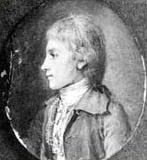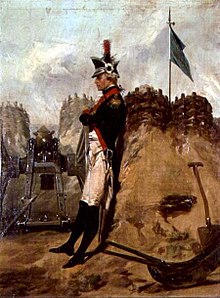Hamiltion
All about Alexander Hamiltion
Last Updated
02/16/22
Chapters
6
Reads
853
Childhood in the Caribbean
Chapter 2
Alexander Hamilton was born and spent part of his childhood in Charlestown, the capital of the island of Nevis in the Leeward Islands (then part of the British West Indies). Hamilton and his older brother James Jr. (1753–1786)[3] were born out of wedlock to Rachel Faucette,[note 1] a married woman of half-British and half-French Huguenot descent,[10] and James A. Hamilton, a Scotsman who was the fourth son of Alexander Hamilton, the laird of Grange in Ayrshire.[11] Speculation that Hamilton's mother was of mixed race, though persistent, is not substantiated by verifiable evidence. Rachel Faucette was listed as white on tax rolls.[12][13]
It is not certain whether Hamilton's birth was in 1755 or 1757.[14] Most historical evidence, after Hamilton's arrival in North America, supports the idea that he was born in 1757, including Hamilton's own writings.[15][16] Hamilton listed his birth year as 1757 when he first arrived in the Thirteen Colonies, and celebrated his birthday on January 11. In later life, he tended to give his age only in round figures. Historians accepted 1757 as his birth year until about 1930, when additional documentation of his early life in the Caribbean was published, initially in Danish. A probate paper from St. Croix in 1768, drafted after the death of Hamilton's mother, listed him as 13 years old, which has caused some historians since the 1930s to favor a birth year of 1755.[1]
Historians have speculated on possible reasons for two different years of birth to have appeared in historical documents. If 1755 is correct, Hamilton might have been trying to appear younger than his college classmates, or perhaps wished to avoid standing out as older.[1] If 1757 is correct, the single probate document indicating a birth year of 1755 may have simply included an error, or Hamilton might once have given his age as 13 after his mother's death in an attempt to appear older and more employable.[17] Historians have pointed out that the probate document contained other proven inaccuracies, demonstrating it was not entirely reliable. Richard Brookhiser noted that "a man is more likely to know his own birthday than a probate court."[15]
Hamilton's mother had been married previously on St. Croix[18] in the Virgin Islands, then ruled by Denmark, to a Danish[6] or German merchant,[19][20] Johann Michael Lavien. They had one son, Peter Lavien.[18] In 1750, Faucette left her husband and first son; then traveled to Saint Kitts where she met James Hamilton.[18] Hamilton and Faucette moved together to Nevis, her birthplace, where she had inherited a seaside lot in town from her father.[1]
James Hamilton later abandoned Rachel Faucette and their two sons, James Jr. and Alexander, allegedly to "spar[e] [her] a charge of bigamy... after finding out that her first husband intend[ed] to divorce her under Danish law on grounds of adultery and desertion."[11] Thereafter, Rachel moved with her two children to St. Croix, where she supported them by keeping a small store in Christiansted. She contracted yellow fever and died on February 19, 1768, at 1:02 am, leaving Hamilton orphaned.[21] This may have had severe emotional consequences for him, even by the standards of an 18th-century childhood.[22] In probate court, Faucette's "first husband seized her estate"[11] and obtained the few valuables that she had owned, including some household silver. Many items were auctioned off, but a friend purchased the family's books and returned them to Hamilton.[23]
Hamilton became a clerk at Beekman and Cruger, a local import-export firm that traded with New York and New England.[24] He and James Jr. were briefly taken in by their cousin Peter Lytton; however, Lytton took his own life in July 1769, leaving his property to his mistress and their son, and the Hamilton brothers were subsequently separated.[23] James apprenticed with a local carpenter, while Alexander was given a home by Nevis merchant Thomas Stevens.[25] Some clues have led to speculation that Stevens was Alexander Hamilton's biological father: his son Edward Stevens became a close friend of Hamilton, the two boys were described as looking much alike, both were fluent in French and shared similar interests.[23] However, this allegation, mostly based on the comments of Timothy Pickering on the resemblance between the two men, has always been vague and unsupported.[26] Rachel Faucette had been living on St. Kitts and Nevis for years at the time when Alexander was conceived, while Thomas Stevens lived on Antigua and St. Croix; also, James Hamilton never disclaimed paternity, and even in later years, signed his letters to Hamilton with "Your very Affectionate Father."[27][28]
Hamilton, despite being only in his teenage years, proved capable enough as a trader to be left in charge of the firm for five months in 1771 while the owner was at sea.[29] He remained an avid reader and later developed an interest in writing. He began to desire a life outside the island where he lived. He wrote a letter to his father that was a detailed account of a hurricane that had devastated Christiansted on August 30, 1772.[30] The Presbyterian Reverend Hugh Knox, a tutor and mentor to Hamilton, submitted the letter for publication in the Royal Danish-American Gazette. The biographer Ron Chernow found the letter astounding for two reasons; first, that "for all its bombastic excesses, it does seem wondrous [that a] self-educated clerk could write with such verve and gusto," and second, that a teenage boy produced an apocalyptic "fire-and-brimstone sermon" viewing the hurricane as a "divine rebuke to human vanity and pomposity."[31] The essay impressed community leaders, who collected a fund to send Hamilton to the North American colonies for his education.[32]
Education
The Church of England denied membership to Alexander and James Hamilton Jr.—and education in the church school—because their parents were not legally married. They received "individual tutoring"[1] and classes in a private school led by a Jewish headmistress.[33] Alexander supplemented his education with the family library of 34 books.[34]
In October 1772 Hamilton arrived by ship in Boston and proceeded from there to New York City. He took lodgings with the Irish-born Hercules Mulligan who, as the brother of a trader known to Hamilton's benefactors, assisted Hamilton in selling cargo that was to pay for his education and support.[35][36] Later in 1772, in preparation for college work, Hamilton began to fill gaps in his education at the Elizabethtown Academy, a preparatory school run by Francis Barber in Elizabethtown, New Jersey. He there came under the influence of William Livingston, a local leading intellectual and revolutionary, with whom he lived for a time.[37][38][39]
Hamilton entered Mulligan's alma mater King's College (now Columbia University) in New York City in the autumn of 1773 "as a private student", again boarding with Mulligan until officially matriculating in May 1774.[40] His college roommate and lifelong friend Robert Troup spoke glowingly of Hamilton's clarity in concisely explaining the patriots' case against the British in what is credited as Hamilton's first public appearance, on July 6, 1774, at the Liberty Pole at King's College.[41] Hamilton, Troup, and four other undergraduates formed an unnamed literary society that is regarded as a precursor of the Philolexian Society.[42][43]
Church of England clergyman Samuel Seabury published a series of pamphlets promoting the Loyalist cause in 1774, to which Hamilton responded anonymously with his first political writings, A Full Vindication of the Measures of Congress and The Farmer Refuted. Seabury essentially tried to provoke fear in the colonies, and his main objective was to stop the potential union among the colonies.[44] Hamilton published two additional pieces attacking the Quebec Act,[45] and may have also authored the fifteen anonymous installments of "The Monitor" for Holt's New York Journal.[46] Hamilton was a supporter of the Revolutionary cause at this pre-war stage, although he did not approve of mob reprisals against Loyalists. On May 10, 1775, Hamilton won credit for saving his college president Myles Cooper, a Loyalist, from an angry mob by speaking to the crowd long enough for Cooper to escape.[47]
Hamilton was forced to discontinue his studies before graduating when the college closed its doors during the British occupation of the city.[48] When the war ended, after some months of self-study, by July 1782 Hamilton passed the bar exam and in October 1782 was licensed to argue cases before the Supreme Court of the State of New York.[49] Hamilton was awarded a Master of Arts degree from the reconstituted Columbia College in 1788 for his work in reopening the college and placing it on firm financial footing. Hamilton was elected a member of the American Philosophical Society in 1791.[50]
Revolutionary War
Early military career
In 1775, after the first engagement of American troops with the British at Lexington and Concord, Hamilton and other King's College students joined a New York volunteer militia company called the Corsicans,[51] later renamed or reformed as the Hearts of Oak.
He drilled with the company, before classes, in the graveyard of nearby St. Paul's Chapel. Hamilton studied military history and tactics on his own and was soon recommended for promotion.[52] Under fire from HMS Asia, he led the Hearts of Oak with support from Hercules Milligan and the Sons of Liberty on a successful raid for British cannons in the Battery, the capture of which resulted in the unit becoming an artillery company thereafter.[53]: 13
Through his connections with influential New York patriots such as Alexander McDougall and John Jay, Hamilton raised the New York Provincial Company of Artillery of 60 men in 1776, and was elected captain.[54] The company took part in the campaign of 1776 around New York City, notably at the Battle of White Plains. At the Battle of Trenton, it was stationed at the high point of town, the meeting of the present Warren and Broad streets, to keep the Hessians pinned in the Trenton Barracks.[55][56]
Hamilton participated in the Battle of Princeton on January 3, 1777. After an initial setback, Washington rallied the American troops and led them in a successful charge against the British forces. After making a brief stand, the British fell back, some leaving Princeton, and others taking up refuge in Nassau Hall. Hamilton brought three cannons up and had them fire upon the building. Then some Americans rushed the front door, and broke it down. The British subsequently put a white flag outside one of the windows;[56] 194 British soldiers walked out of the building and laid down their arms, thus ending the battle in an American victory.[57]







